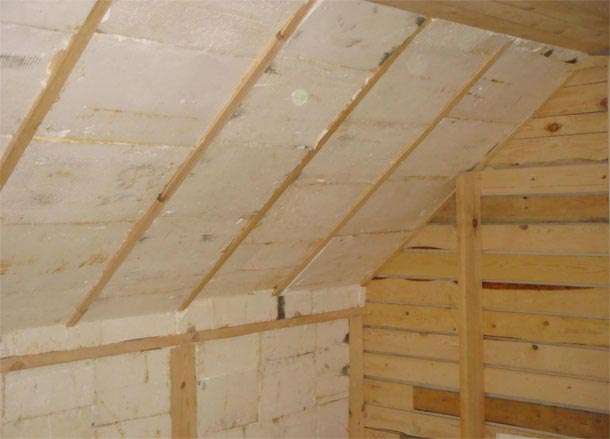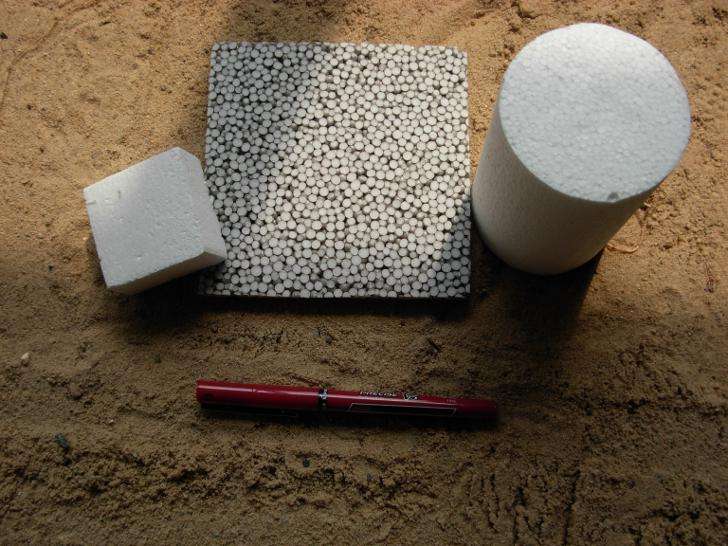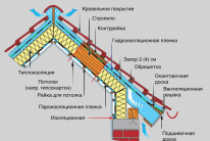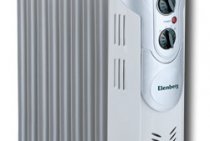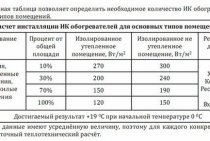Flat roof insulation
If a decision has been made on what kind of insulation to perform thermal insulation, and this is foam, then before carrying out work on laying the material, you should prepare the surface - clean it from the previous backfill. Then waterproofing is laid on the structure to prevent moisture from penetrating. The ingress of water on the insulation reduces its performance.
After creating a waterproofing layer, foam boards are laid on it
Particular attention is paid to the fit of the elements to be combined, since large gaps and gaps should not be allowed. The service life of the created thermal protection depends on many factors, including how correctly the thickness of the attic or roof insulation is chosen (read the article: “The thickness of the insulation for the roof and methods of insulation”).
One of the important points is the angle of the roof slope - the minimum slope cannot be less than 25 degrees, otherwise it is impossible to ensure normal flow from the roof of precipitation and they will accumulate on its surface. Water must be allowed to flow freely into the gutters. In this matter, the main thing is not to overdo it and not to make too steep slopes on the roof.
Features of thermal insulation
Heat loss at home.
Attic insulation should not allow moisture, as well as heat and cold, to enter the upper floor from the street. At the ceiling, the air will always be warmer, since cold air is always at the bottom, moving warm air up. In any case, the heat loss from the wall and roof will vary greatly, even if the layers of materials are the same in thickness. In addition, due to changes in air temperature in the ceiling area in the attic, condensate may appear, which can spoil the performance of the structure.
The attic ceiling area is more susceptible to damage than the rest of the elements, for example, a certain temperature change that can cause condensation on the attic ceiling will not affect the walls in any way. Attic rooms are insulated according to much more stringent criteria than the rest of the building. Due to significant heat losses, proper insulation of the attic and walls can greatly reduce the cost of material and additions to it. In addition, modern methods of thermal insulation can seriously increase the thermal insulation qualities of expanded polystyrene, which can reduce the use of heating. Insufficient insulation of various parts of the roof can lead to the appearance of large icicles, which, if they fall, can harm the physical health of a person. And if you try to knock down icicles, then the roof can be damaged.
In order to avoid the formation of condensate on the walls and ceiling in the attic, it is necessary to carry out a vapor barrier.
Well-made thermal insulation of the attic will not allow icicles to appear. Warming is also necessary for the rafter system, otherwise the entire structure will not have the necessary properties and characteristics.
Before carrying out installation work, it should be taken into account that the amount of moisture in heated air varies greatly compared to cold air, because of this, the moisture that is in the air is released into the external environment. The waterproofing material, which is installed in almost all buildings, cannot remove moisture to the outside, which can cause all sorts of mold and fungal spores on the walls.
Drops of moisture that may form on the surface of the ceiling are not the result of leaks in the roof, but are only formed due to too much condensation. Therefore, in order to avoid this unfavorable phenomenon, insulation should be carried out using a layer of vapor barrier material.Often it is located on top of the base. In order for moisture to be removed from the roof elements, an air cushion must be made, which will act as a kind of ventilation.
Attic insulation stages of work
Considering all of the above, you can proceed to the thermal insulation of the roof with your own hands using extruded polystyrene foam. Expanded polystyrene is a modern descendant of polystyrene, but it is better than it in terms of strength and insulating characteristics. Sufficiently resistant to UV radiation. It is produced in the form of sheets of various sizes and colors.
Tools and materials
So, for work you will need:
Attic insulation tools.
- expanded polystyrene plates of suitable thickness;
- reinforcing fiberglass mesh;
- diffusion membrane;
- stapler;
- adhesive composition;
- cladding material (decorative plaster, lining, siding, etc.);
- wooden beam with a thickness of 3.5 to 4 cm;
- nails;
- hammer;
- saw;
- ax and other carpentry tools.
If the roof has already been completed according to all the canons, it must be waterproofed. Waterproofing - a film over the entire area of the roof, which is located directly under the roof itself. In its absence, you need to do the installation from the outside - you need to disassemble the roof and make a waterproofing coating.
First of all, it is necessary to treat the wooden parts of the roof with antiseptic agents and allow them to soak and dry well. It is much better if the surface is treated with a fire retardant compound.
The next step is the installation of sheets of extruded polystyrene foam in the gaps between the roof rafters. To do this, you need to use special products for fasteners - brackets or corners (which can be easily purchased at the store). In addition, they can be supported with thin slats attached across the rafters.
The gap between the waterproofing layer and the sheets should be from 20 to 50 cm: for better ventilation. It is necessary to mount the sheets carefully so that there are no gaps between them and the rafters. If the gaps still appear, you need to fill them with cut pieces from polystyrene foam sheets or foam for mounting. Most often, the thickness of the sheets is slightly less than the thickness of the "legs" of the rafters. If so, the sheets are not laid in one layer, and the fasteners (joints) of the sheets are made on different sides - in order to prevent gaps. Mounted and fixed sheets together with mounting rails must have a flat surface without protruding bumps and slots.
Then a layer for vapor barrier is mounted. For this, a special film is used. It can be ordinary or like a membrane: foil or perforated.
The film is mounted to the rafters using a stapler with a slight overlap of 10-15 cm. All joints are glued with a special tape. This is necessary so that the vapor barrier properties do not decrease at the points of contact with the rafters. The tape should be glued across the rafters. The tension of the film should be medium, it is better to let it sag a little (up to 1 cm) in the center of the opening.
At the final stage, a fine finish is carried out - finishing materials are mounted. It can be fastened closely, adjacent to the vapor barrier, or on a thin crate of slats. If there is a need, the surface is covered with wallpaper, varnish or paint.
At all installation phases, one should not forget to make high-quality insulation of engineering systems, if any. It is better to install electrical wiring in a non-combustible cable channel or corrugation, and use metal and asbestos materials for the chimney.
Advantages and disadvantages of expanded polystyrene
Technical characteristics of expanded polystyrene boards.
The material is very durable, weakly compressible, because of this it can last a long time. They do not react in any way to chemistry and various kinds of biological manifestations, and because of its composition, neither insects, nor fungi and bacteria can appear in it.Styrofoam should not be allowed to come into contact with gasoline or thinner, as they can damage it. This is an excellent sound insulator, so extraneous sounds cannot get into the attic, insulated with polystyrene foam. Expanded polystyrene can be used both outdoors and indoors, which allows it to be a very valuable material for insulating a mansard roof.
Its main disadvantage can be considered that it is combustible, but this property can be reduced by adding fire retardants to the composition when preparing polystyrene foam. Once added, these substances will prevent the spread of fire.
Features of insulation with foam boards
When, after laying the foam plates, visible joints form between them, they should certainly be sealed, for which polyurethane foam, which is produced in the form of mounting foam, is ideal. It is desirable to prevent the formation of cold bridges by filling even the smallest gaps.
When the attic is insulated from the inside with foam, for greater reliability, the plates are attached to the surface using nails, dowels or adhesives (see: "Insulation of the attic roof from the inside, how to avoid mistakes"). But glue, even of high quality, loses its properties over time, but additional fastening with nails ensures the durability of the surface (read: “We do roof insulation with foam plastic correctly”).
Before insulating the attic with polystyrene foam, it is necessary to purchase not only insulation, but also finishing materials. Often these are products made from natural wood. Sometimes a more expensive option is used: a special frame is created, plates with a finishing layer are inserted into it.
Why a tree cannot be insulated with foam, an example in the video:
Calculation of the amount of foam
Before starting work, it is necessary to calculate the thickness of the attic insulation and, accordingly, determine the number of foam boards so that the entire area of \u200b\u200bthe roof structure is covered with it. At the same time, it is necessary to buy material with a margin, since an unforeseen situation may arise during the installation process. For example, when cutting foam, the material needed to be given a certain shape, but a mistake was made. Other troubles are also possible. Therefore, if the calculations showed that at least 40 slabs would be required, it is advisable to purchase 50 before insulating the mansard roof.
If the material remains, it will be useful in the future to replace the elements that have become unusable. During transportation, the foam must be protected from mechanical damage and physical stress, and if it is transported in an open body, then from atmospheric precipitation.
Criterias of choice
Attic insulation is a much more complicated process than insulation of floors, walls, windows and basements.
Here the specifics of a broken roof, which usually forms an attic, the presence of a crate matters - the insulation must be laid between the rafters and behind them, securely fixed and not change shape for a long time, despite the vertical arrangement, it should not move away and sag.
It is also necessary to insulate walls, ceilings, floors, gables - a sufficiently rigid material with good insulating properties is required.
If you choose between polystyrene foam, polystyrene foam and mineral wool, you should choose the latter. Despite its higher cost, mineral wool has a whole range of useful properties that are superior to other heat-insulating agents.
It is environmentally friendly, retains its shape better than polystyrene foam and polystyrene foam, is not afraid of mice, unlike polystyrene foam, and unlike polystyrene foam, it is better ventilated and allows you to insulate the room with high quality, taking into account the need to live in it in the summer.
Stages of attic insulation from the selection and calculation of insulation to installation
But if, when heated, the foam releases only styrene, then during combustion, vapors of hydrogen cyanide and toluene diisocyanate are formed (TDI), which are highly toxic.
Due to the danger to human health, foam is prohibited for indoor use. Its only purpose is building facades. And now we will answer the question of why polystyrene is good as a heater.
Styrofoam is mostly air. And, as you know, the air layer is an excellent insulation. If you use polystyrene foam correctly for insulation, then you will not be afraid of any severe frosts. Heat loss through the walls of the building is reduced by 40%. But the foam will only “work” if used correctly.
Many firms and private contractors offer foam insulation services for facades. Unfortunately, non-compliance with the rules for using this material leads to the fact that the insulation does not give any result, moreover, mold forms in the apartment. And the problem is here vapor permeability of walls and poor hoods in the bathroom and kitchen. Add plastic windows to everything, and problems with steam will lead to the development of fungus on the walls and ceiling.
A small part of the steam (from 3 to 5%) passes through the walls (whether it be a panel or a brick house). Of course, hoods are responsible for most of the steam removal, but in many homes they work very poorly. Steam also passes through wooden windows, but not through plastic ones.
Please note that in many cases, after installing plastic windows in winter, condensation is observed on the glass. This is already evidence of the poor performance of the hoods.
Adding another layer of material to the wall, i.e. foam, which has a low vapor permeability, leads to the formation of condensation on the outer surface of the wall.
Moisture under the foam does not go anywhere. As a result the wet facade of the building not only does not heat, but also worsens the microclimate in the apartment. From here, mold appears in the apartment, from which it is impossible to get rid of. The situation is worsened by the fact that moisture negatively affects the facade of the building and, under its action, bricks and panels begin to collapse. In winter, condensation turns into ice, which tends to accumulate. As a result, the foam is bent.
Failure to comply with the rules for insulating the house with foam plastic leads to all these problems. Therefore, before deciding to use foam, check the correct operation of the hoods in the house. Also do not be stingy and install a vapor barrier on the inside, which prevents the penetration of steam through the walls of the building.
It makes no sense to be afraid of polystyrene as a dangerous substance. Subject to simple rules in a foam-insulated apartment or house, there will be no problems with steam and mold. But in winter it will be very warm and comfortable inside.
What is this room
Attic is a category of living space located in the attic space, usually located under a specialized sloping (otherwise - mansard) roof.
According to the Russian classification (SNiP 2.08.01-89), an attic is a room where the line of intersection of the roof and the facade is not higher than 1.5 meters.
The attic is in the most specific temperature conditions within the house - in summer the roof can heat up above seventy degrees and transfer heat to the attic, in winter 50% of heat loss goes through the roof and about 15% more through the walls of the attic.
In such conditions, the living space in the attic must be well insulated, not only taking into account the cold weather, but also taking into account the need for a comfortable stay there in hot weather.
There is one universal recommendation for competent attic insulation - the materials used (if we take the middle band as the standard) should not exceed 0.04 W / m2 C in terms of thermal conductivity.
Usually, from half a meter to a meter of roofing cake space is enough for an attic, for colder regions this volume can be increased by 25-35%, and for warmer regions it is reduced by 40-50%.
